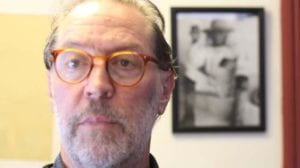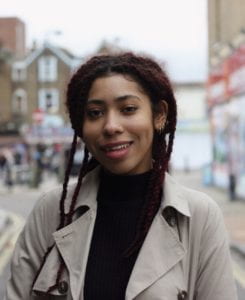 Last month, the memorial for Professor Stephen Nugent was held in East London, who sadly passed away in November last year. Emeritus Professor, Brian Morris spoke at the memorial and has shared his tribute to Steve.
Last month, the memorial for Professor Stephen Nugent was held in East London, who sadly passed away in November last year. Emeritus Professor, Brian Morris spoke at the memorial and has shared his tribute to Steve.
STEPHEN NUGENT (1950-2018 – A TRIBUTE) – written by Brian Morris
(1) INTRODUCTION
Steve Nugent was my friend and colleague at Goldsmiths College for over forty years. We were students together at the London School of Economics, undertaking postgraduate studies in anthropology and I first met Steve through our mutual friend Olivia Harris. In the 1970’s I went to undertake ethnographical studies of a South Indian community; Olivia went to Bolivia to study peasants; and Steve went off to the Amazon, significantly not to study some remote Amerindian community, but to study the people – the Caboclos – of the city of Santarem on the southern bank of the Amazon.
I always found Steve something of an enigma, and he continually berated me for my lack of technological skills, but when he came to my surprise birthday party in October 2016, I felt deeply touched. As a birthday present he gave me a biography of Henry Walter Bates – the naturalist of the Amazons. In fact, had it not been for Steve’s cajoling I probably would never have become a professor.
How then does one describe Steve Nugent? On his passing last November the Anthropology blog at Goldsmiths described Steve as “fiercely intelligent, defiant, loyal, caring, sceptical, humorous, persistently inspiring and forever disruptive!” He wasn’t so much disruptive as critical, for as a libertarian Marxist, he had a deep sense of dialectics. His relationship to both the Anthropology Department at Goldsmiths College and anthropology was therefore always one of unity in opposition.
Steve, as is well-known, was multi-talented, but I knew little of Steve in relation to his family life, or to his talents as a rock musician, or to his important contributions as a film-maker. I shall, therefore, simply offer my recollections of Steve as a colleague at Goldsmiths College, and as a unique and talented anthropologist.
(2) GOLDSMITHS ANTHROPOLOGY DEPARTMENT.
Anthropology began at Goldsmiths College in 1975 when I was appointed as its first lecturer in anthropology. In those days Goldsmiths was viewed very much as a teacher-training college and Art School, and the degree courses came under the University of London regulations which stipulated that all undergraduate students had to take a subsidiary or “other” subject. I thus taught anthropology to a wide range of students taking degrees in psychology, geography, biology, French, chemistry and the like. I was a kind of evangelist, and as I had so many students taking anthropology as a subsidiary subject, the college agreed that I needed some support. In 1977 Pat Caplan joined me in the psychology department.
As there were then moves afoot with regard to the restructuring of the degree programme within Goldsmiths College, in 1978 Pat and I had the temerity to draft an outline for a degree programme in anthropology. The then warden, Richard Hoggart, was somewhat alarmed, and appointed an informal committee of anthropologists to advise him on the teaching of anthropology within the college. They approved our proposal but insisted that the college would have to appoint at least five members of staff. Thus in 1980 anthropology was established as a degree programme at Goldsmiths College. Steve was a member of the Department from the very beginning, being appointed in 1981. There were five of us in the Department; Pat Caplan, Nici Nelson, Olivia Harris, myself and Steve.
From the beginning the Anthropology Dept. at Goldsmiths’ sought to be different from other departments, and we adopted an ethos which consisted essentially of three aspects.
The first was that we would try to develop strong links with the local community at New Cross, continuing the ethos that had already been established at Goldsmiths, which was never a cloistered university. Indeed, anthropology was part of the Faculty of Adult Studies, and in the early days there were more students around in the evening than during the day!
Secondly, we were committed to developing a department that expressed a critical anthropology, both in terms of embracing a radical politics, and in terms of taking a critical stance within the discipline. The right-wing philosopher Roger Scruton has recently bewailed the fact that universities are full of academics who have left-wing sympathies and he advocates the privatization of higher education. Unlike Scruton we sided with Socrates, feeling that as teachers we should encourage students to critically engage with the societies in which they live.
Finally, we felt that the anthropology department at Goldsmiths should be innovative, and from the outset we developed new innovative courses. One, “Psychological Perspectives in Anthropology” was taught by Steve and me over many years, as Steve had a strong interest in cognitive sciences. But we also had courses on “Sex and Gender” (then a novelty), the “Anthropology of Food”, on medical anthropology “Health, Medicine and Social Power” and later, a course Steve and I devised in “Environmental Anthropology” (long before ecology became a fashionable topic). We also initiated the first access course in anthropology. But perhaps in retrospect the most significant innovation was a course that had the title: “Anthropology, Representation and Contemporary Media”. I signed the course proposal when head of department in November 1984. Of interest is that “images of the primitive” and “ethnographic film as a form of knowledge” are listed among the scope of the course, and that “training in video techniques” was a practical aspect of the course. This course was therefore the embryo or seed that led eventually, largely through Steve’s enthusiasm and initiative, to the setting up of an MA in visual anthropology and the foundation of a Centre for Visual Anthropology.
Steve had two long spells as head of department and played a very significant and crucial role in the development and expansion of Goldsmiths’ Anthropology Department. In the early 1980’s there were five of us teaching joint degrees in anthropology and geography (we became a department in 1986); at the present time it is a large and flourishing department with twenty-five academic staff teaching five undergraduate and eight postgraduate degrees in anthropology, especially visual anthropology, at Goldsmiths College.
Yet it is well to recall that Steve always had a dialectical approach to Goldsmiths College, especially in the early years, and, to express this, at departmental meetings he would sit separately on the floor reading a book – (Adorno’s “Negative Dialectics” seems to have been a favourite). Nevertheless, he would always participate in the proceedings, often making some inspired comment, or crack a joke that would dispel any pretentions we may have had.
(3) CRITICAL ANTHROPOLOGY.
You are perhaps aware that anthropology is often viewed as going through a series of theoretical “turns” – radical changes in its approach to the understanding of human societies. In the 1970’s there was the “symbolic” or “interpretive” turn associated with Clifford Geertz, David Pocock and Mary Douglas: in the 1980’s there was the literary or postmodernist turn, associated with James Clifford and Stephen Tyler; while at the turn of the present century there was the so-called “ontological” turn –particularly associated with Cambridge University and the acolytes of Marilyn Strathern and Eduardo Viveiros de Castro.
Although Steve engaged theoretically with these various anthropological “turns”, we do well to recall that he had very little time or sympathy with what he described as “mainstream” anthropology. He was highly critical of the narcissistic aspects of the “literary” turns which tended to view Nietzsche and Heidegger as “fonts” of anthropological wisdom. Steve was also concerned to go beyond the concerns of pure ethnography, and he bewailed the tendency of many anthropologists to focus on the more “exotic” aspects of a generalized “other”, to the complete neglect of concrete historical analysis, as well as the abandoning of any attempt to “explain” human social life and culture. I therefore always looked upon Steve as a kindred spirit, for he was essentially a historical anthropologist. He stood firmly in the Marxist tradition of Eric Wolf, Sydney Mintz and Immanuel Wallerstein. He was for many years editor of the journal “Critique of Anthropology”, and included among his close associates radical scholars such as Mike Rowlands, John Gledhill and the late Josep Llobera.
Steve’s kind of anthropology was therefore realist – “down to earth” long before Bruno Latour – materialist – in marked contrast to the cultural idealism that permeated mainstream anthropology – historical and critical, as well as being inter-disciplinary. Indeed, as Mark Harris stressed, Steve was an avid reader of all things Amazonian, and drew for his studies on a wide range of sources – from the biological sciences to archaeology, economics and political ecology. Anthropology, for Steve, was therefore the study of concrete historical societies, and we should, he felt, seek to understand the underlying causes of social change. Given the modern crisis – social and ecological- Steve always lamented that the study of political economy had tended to be marginalized in recent anthropology.
Steve’s three key texts on the Amazonian region –“Amazonian Caboclo Society” (1993), “Scoping the Amazon” (2007) and “The Rise and Fall of the Amazon Rubber Industry” (2018) – are truly pioneering studies of historical anthropology – substantive, well-researched, politically engaging, and highly critical of the stereotypical portrayals of the Amazonian region and its people that tend to pervade literature – both popular and academic. All three books in fact reflect Steve’s ardent concern to challenge the common portrayal of Amazonia as a “green hell”; as a region that is inimical to human life, and is resistant to social complexity, and is thus inhabited only by the stereotypical forest-dwelling noble savage. Indeed, in one of his last essays (2016) he berates the doyen of the so-called “ontological” turn for not only portraying Amerindians as the “exotic” other, but of offering us “exotic theory” masquerading as original scholarship. Stephen Nugent’s studies of Amazonia and its people are, I think, important, unique and enduring contributions to anthropology.
As an inspiring and challenging teacher; as a key figure in the development and flourishing of the Anthropology Department at Goldsmiths College; as a unique historical anthropologist whose pioneering studies of Amazonia have an enduring value; and as a friend and colleague and supporter for over forty years, “old Steve” will be sadly missed.
BRIAN MORRIS
20TH June 2019
 Rambisayi, BA Anthropology and Visual Practice
Rambisayi, BA Anthropology and Visual Practice  Nicole, BA Anthropology and Visual Practice
Nicole, BA Anthropology and Visual Practice 